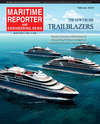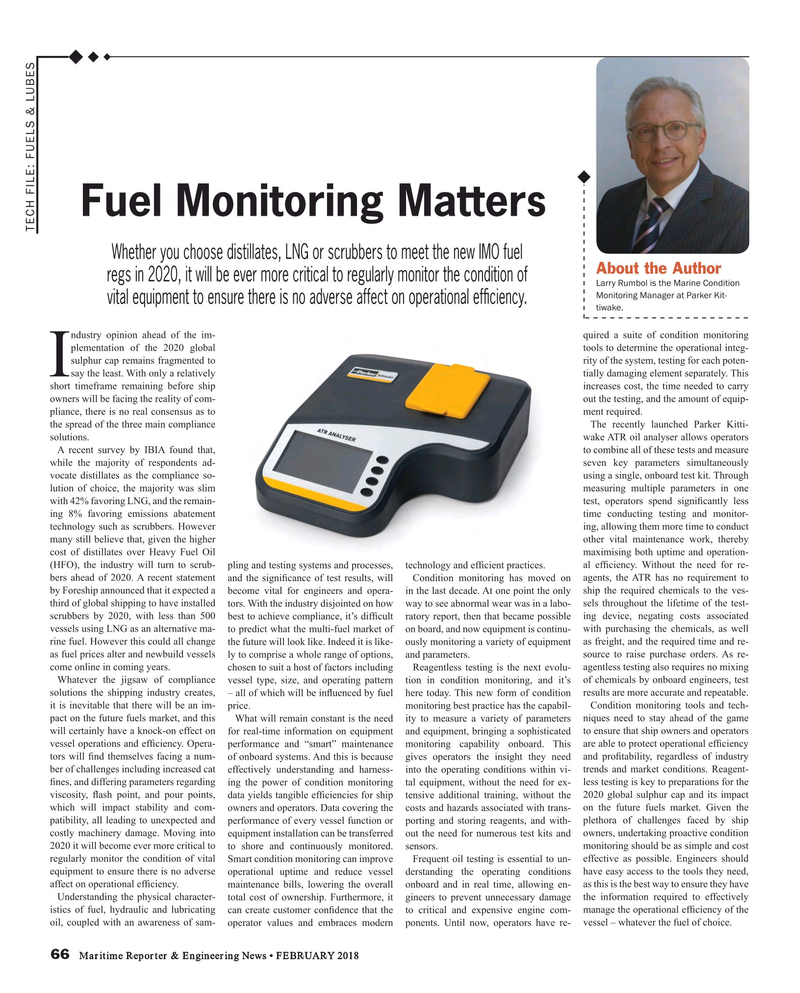
Page 66: of Maritime Reporter Magazine (February 2018)
Cruise Ship Annual
Read this page in Pdf, Flash or Html5 edition of February 2018 Maritime Reporter Magazine
Fuel Monitoring Matters
TECH FILE: FUELS & LUBES
Whether you choose distillates, LNG or scrubbers to meet the new IMO fuel
About the Author regs in 2020, it will be ever more critical to regularly monitor the condition of
Larry Rumbol is the Marine Condition
Monitoring Manager at Parker Kit- vital equipment to ensure there is no adverse affect on operational ef? ciency. tiwake.
ndustry opinion ahead of the im- quired a suite of condition monitoring plementation of the 2020 global tools to determine the operational integ- sulphur cap remains fragmented to rity of the system, testing for each poten-
Isay the least. With only a relatively tially damaging element separately. This short timeframe remaining before ship increases cost, the time needed to carry owners will be facing the reality of com- out the testing, and the amount of equip- pliance, there is no real consensus as to ment required. the spread of the three main compliance The recently launched Parker Kitti- solutions. wake ATR oil analyser allows operators
A recent survey by IBIA found that, to combine all of these tests and measure while the majority of respondents ad- seven key parameters simultaneously vocate distillates as the compliance so- using a single, onboard test kit. Through lution of choice, the majority was slim measuring multiple parameters in one with 42% favoring LNG, and the remain- test, operators spend signi? cantly less ing 8% favoring emissions abatement time conducting testing and monitor- technology such as scrubbers. However ing, allowing them more time to conduct many still believe that, given the higher other vital maintenance work, thereby cost of distillates over Heavy Fuel Oil maximising both uptime and operation- (HFO), the industry will turn to scrub- pling and testing systems and processes, technology and ef? cient practices. al ef? ciency. Without the need for re- bers ahead of 2020. A recent statement and the signi? cance of test results, will Condition monitoring has moved on agents, the ATR has no requirement to by Foreship announced that it expected a become vital for engineers and opera- in the last decade. At one point the only ship the required chemicals to the ves- third of global shipping to have installed tors. With the industry disjointed on how way to see abnormal wear was in a labo- sels throughout the lifetime of the test- scrubbers by 2020, with less than 500 best to achieve compliance, it’s dif? cult ratory report, then that became possible ing device, negating costs associated vessels using LNG as an alternative ma- to predict what the multi-fuel market of on board, and now equipment is continu- with purchasing the chemicals, as well rine fuel. However this could all change the future will look like. Indeed it is like- ously monitoring a variety of equipment as freight, and the required time and re- as fuel prices alter and newbuild vessels ly to comprise a whole range of options, and parameters. source to raise purchase orders. As re- come online in coming years. chosen to suit a host of factors including Reagentless testing is the next evolu- agentless testing also requires no mixing
Whatever the jigsaw of compliance vessel type, size, and operating pattern tion in condition monitoring, and it’s of chemicals by onboard engineers, test solutions the shipping industry creates, – all of which will be in? uenced by fuel here today. This new form of condition results are more accurate and repeatable. it is inevitable that there will be an im- price. monitoring best practice has the capabil- Condition monitoring tools and tech- pact on the future fuels market, and this What will remain constant is the need ity to measure a variety of parameters niques need to stay ahead of the game will certainly have a knock-on effect on for real-time information on equipment and equipment, bringing a sophisticated to ensure that ship owners and operators vessel operations and ef? ciency. Opera- performance and “smart” maintenance monitoring capability onboard. This are able to protect operational ef? ciency tors will ? nd themselves facing a num- of onboard systems. And this is because gives operators the insight they need and pro? tability, regardless of industry ber of challenges including increased cat effectively understanding and harness- into the operating conditions within vi- trends and market conditions. Reagent- ? nes, and differing parameters regarding ing the power of condition monitoring tal equipment, without the need for ex- less testing is key to preparations for the viscosity, ? ash point, and pour points, data yields tangible ef? ciencies for ship tensive additional training, without the 2020 global sulphur cap and its impact which will impact stability and com- owners and operators. Data covering the costs and hazards associated with trans- on the future fuels market. Given the patibility, all leading to unexpected and performance of every vessel function or porting and storing reagents, and with- plethora of challenges faced by ship costly machinery damage. Moving into equipment installation can be transferred out the need for numerous test kits and owners, undertaking proactive condition 2020 it will become ever more critical to to shore and continuously monitored. sensors. monitoring should be as simple and cost regularly monitor the condition of vital Smart condition monitoring can improve Frequent oil testing is essential to un- effective as possible. Engineers should equipment to ensure there is no adverse operational uptime and reduce vessel derstanding the operating conditions have easy access to the tools they need, affect on operational ef? ciency. maintenance bills, lowering the overall onboard and in real time, allowing en- as this is the best way to ensure they have
Understanding the physical character- total cost of ownership. Furthermore, it gineers to prevent unnecessary damage the information required to effectively istics of fuel, hydraulic and lubricating can create customer con? dence that the to critical and expensive engine com- manage the operational ef? ciency of the oil, coupled with an awareness of sam- operator values and embraces modern ponents. Until now, operators have re- vessel – whatever the fuel of choice.
66 Maritime Reporter & Engineering News • FEBRUARY 2018
MR #2 (66-73).indd 66 MR #2 (66-73).indd 66 2/8/2018 10:48:12 AM2/8/2018 10:48:12 AM

 65
65

 67
67
